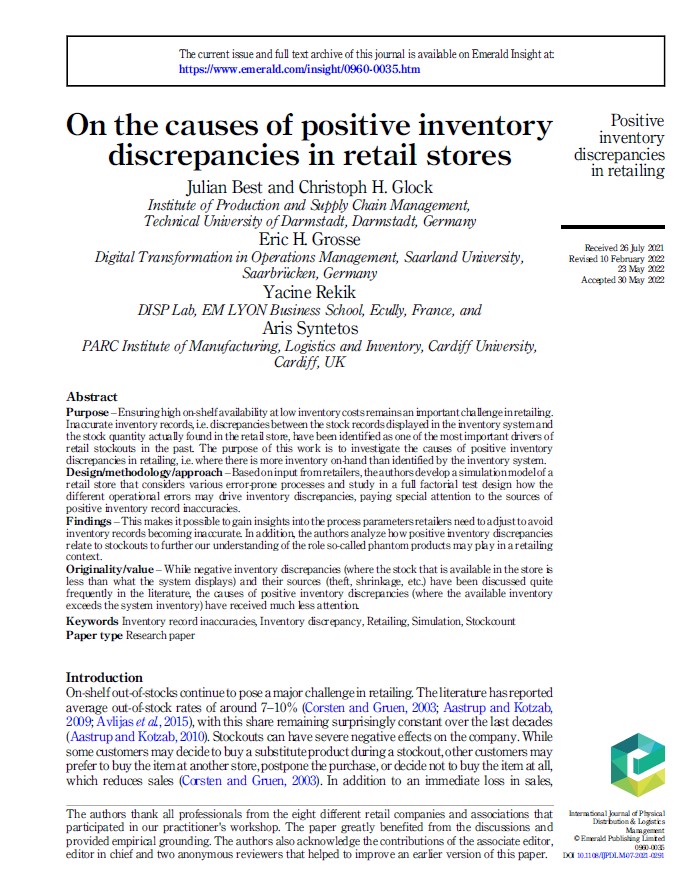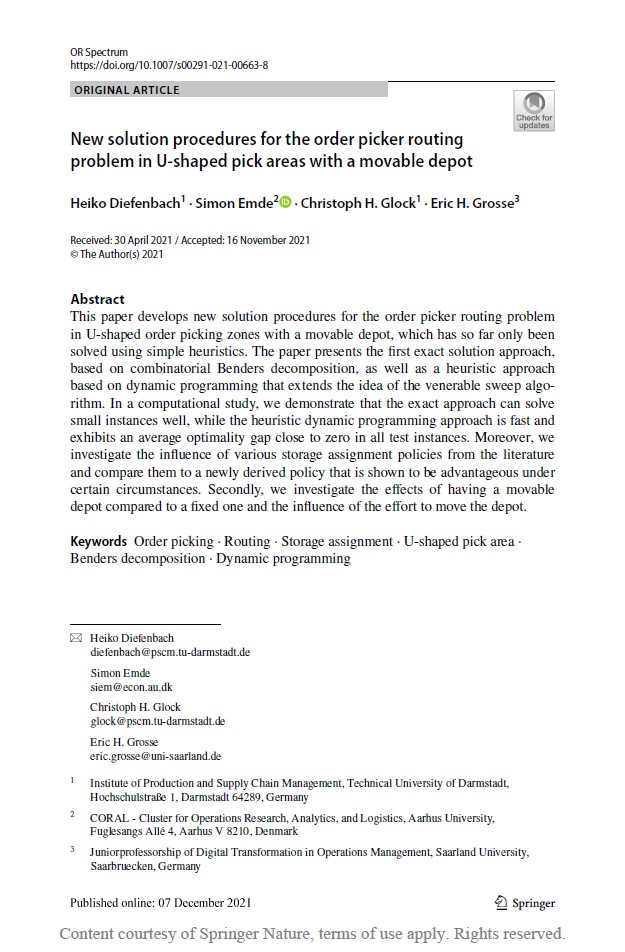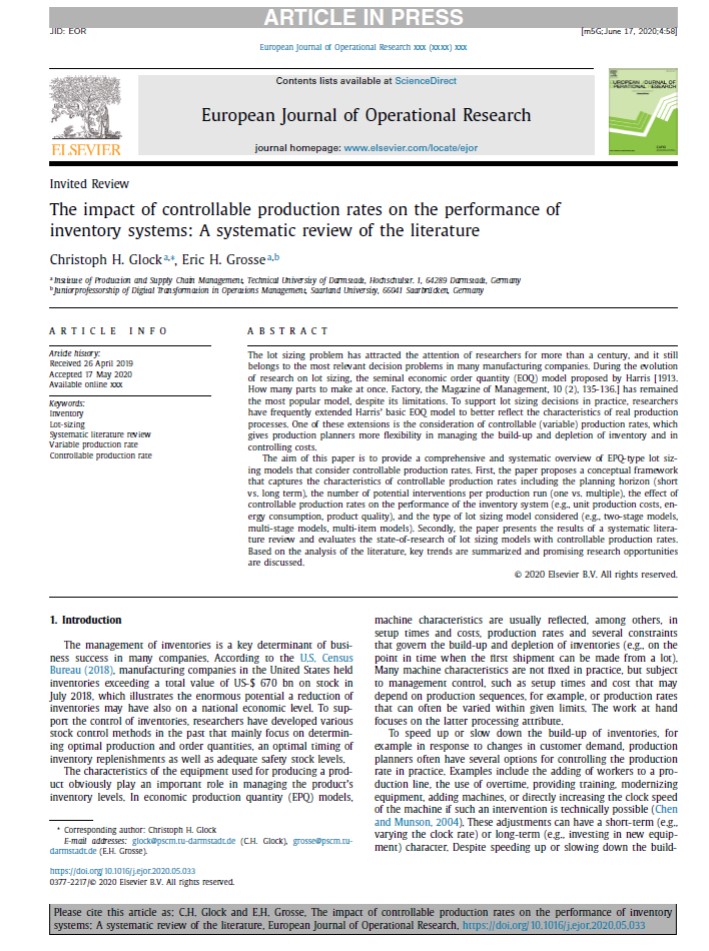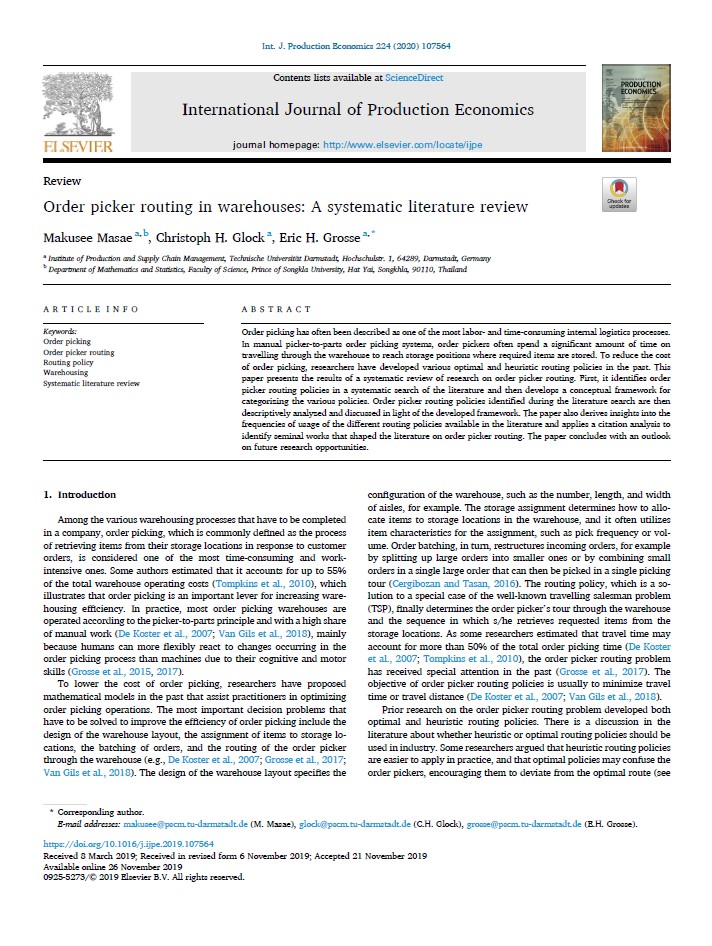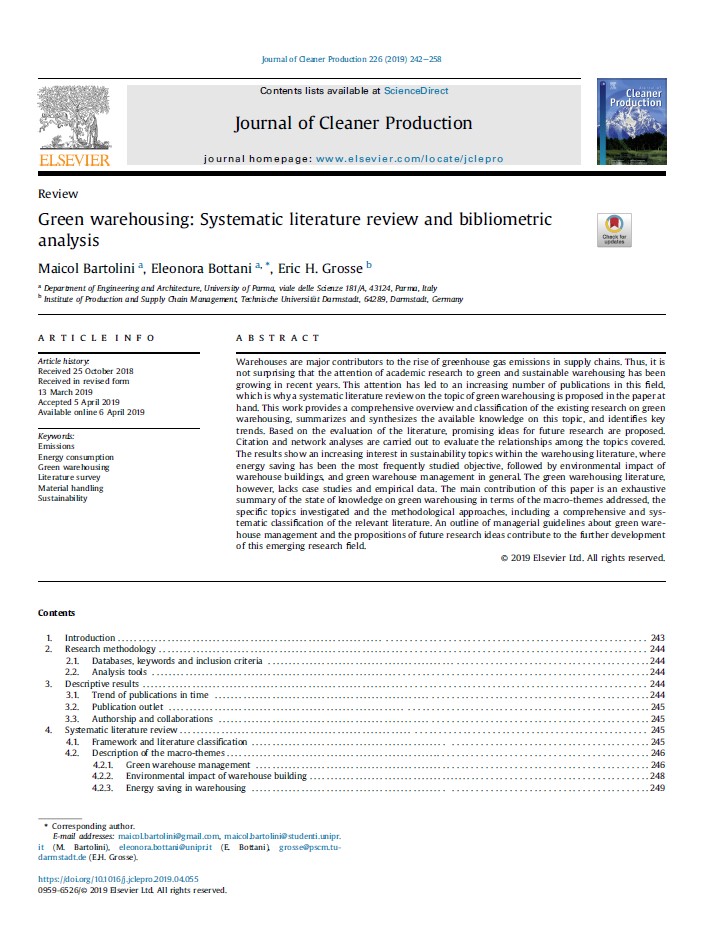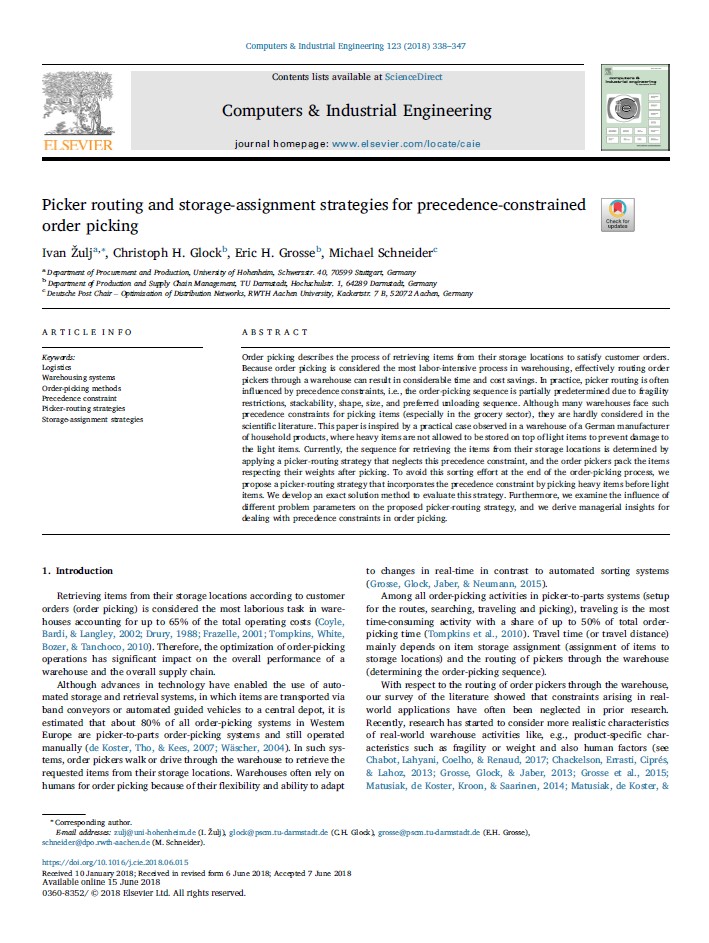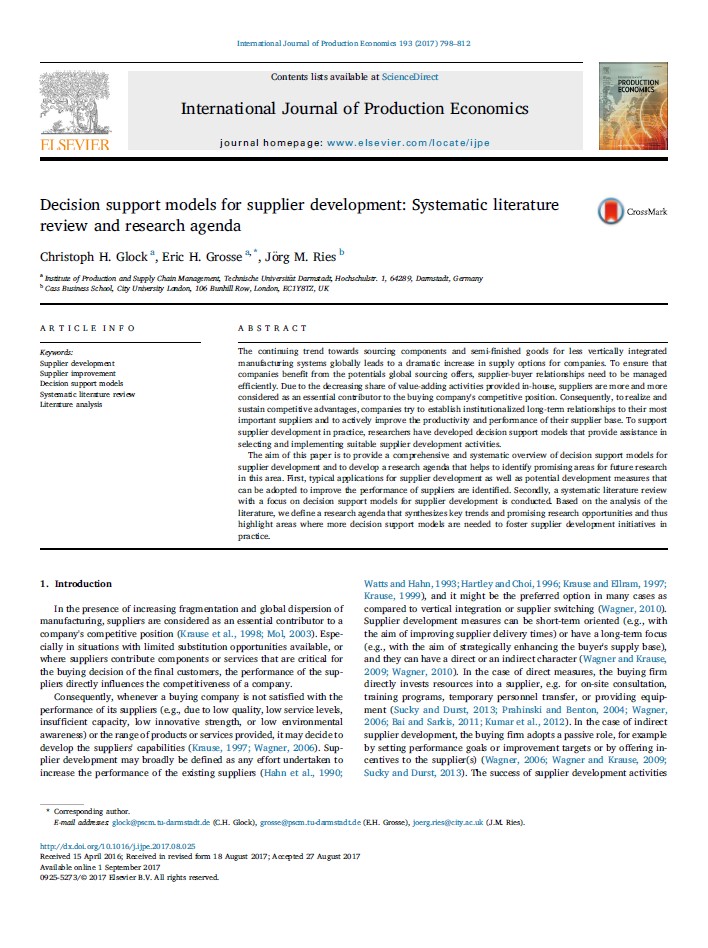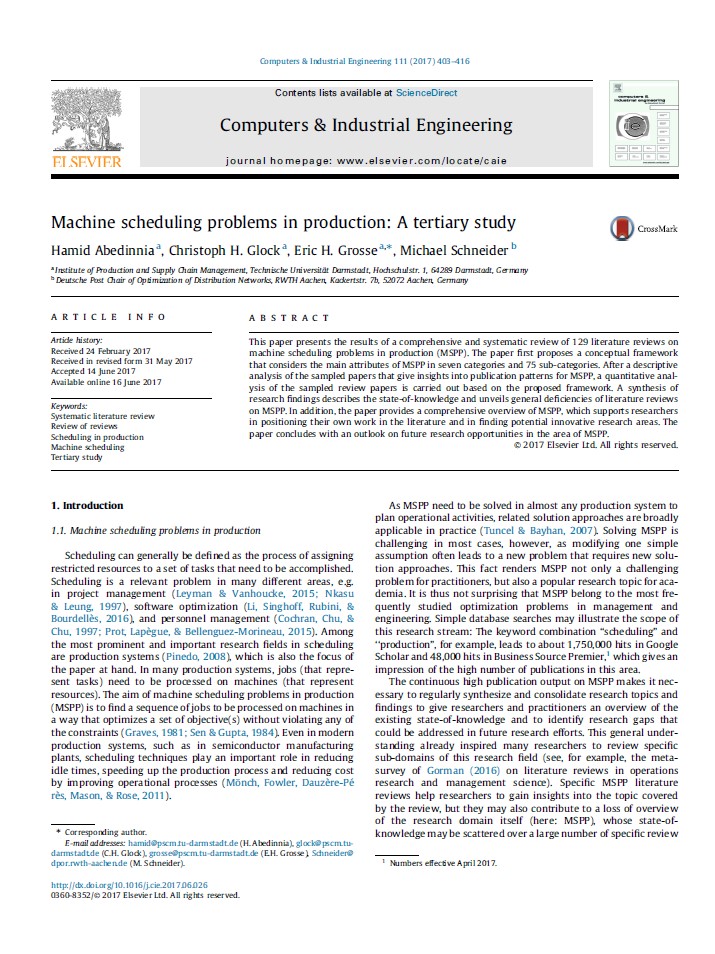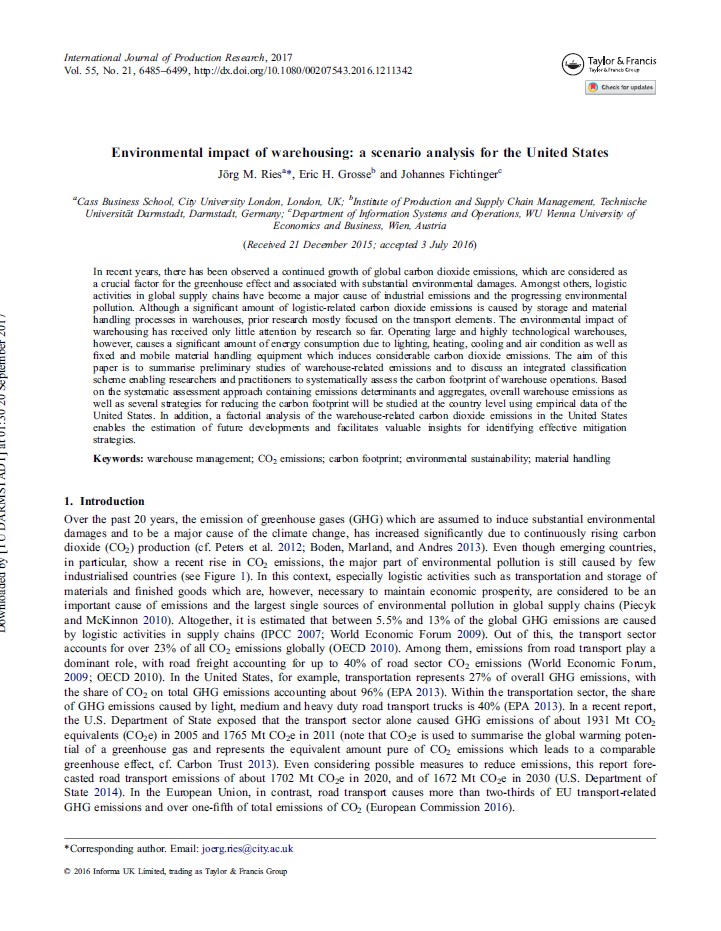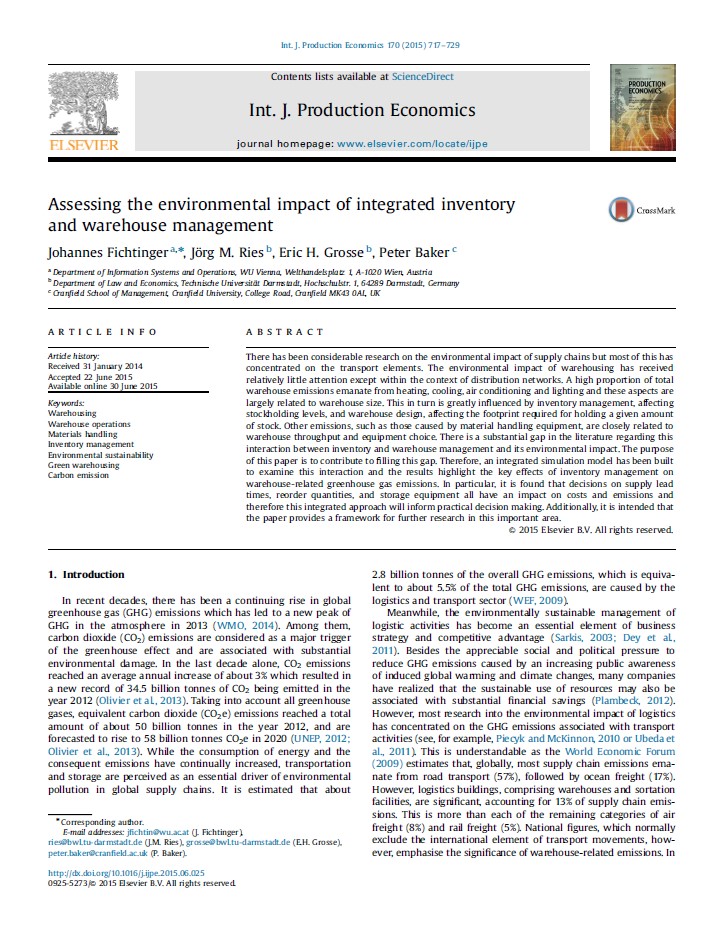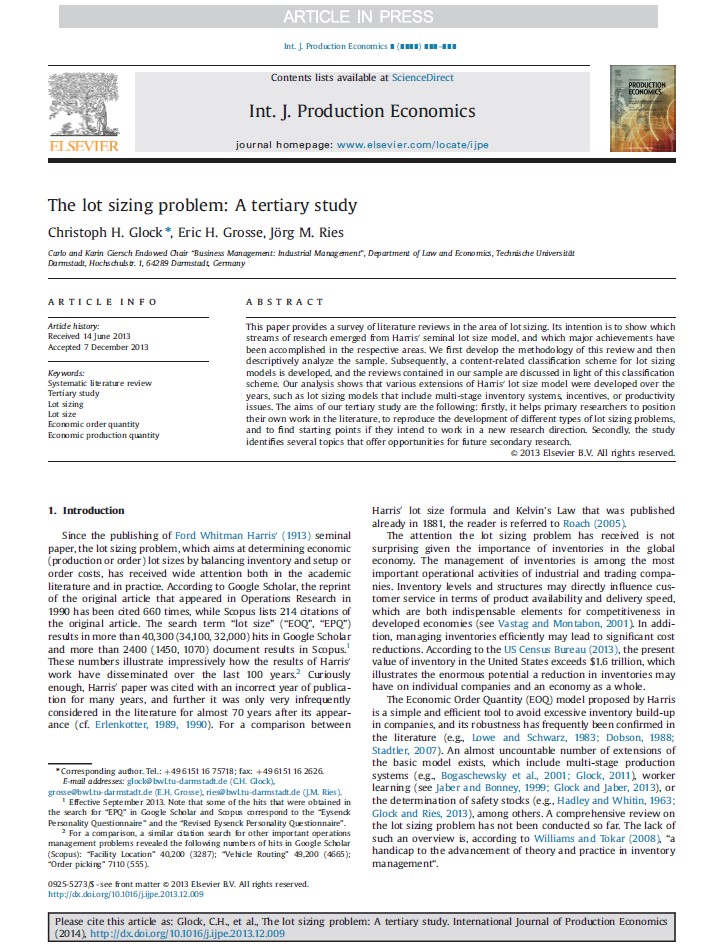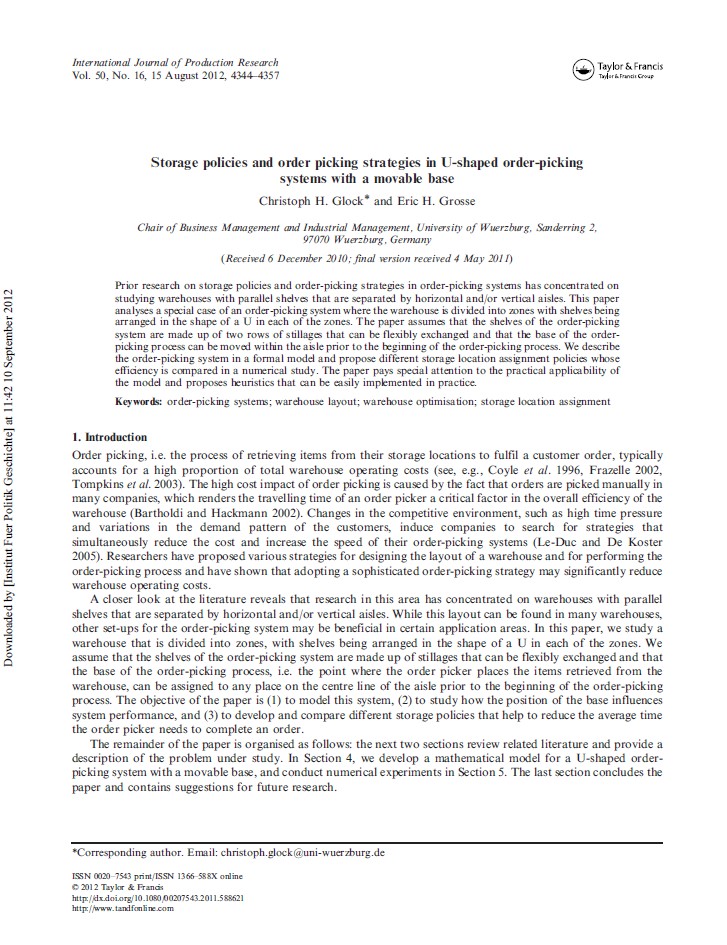Warehouse optimization
Publikationen
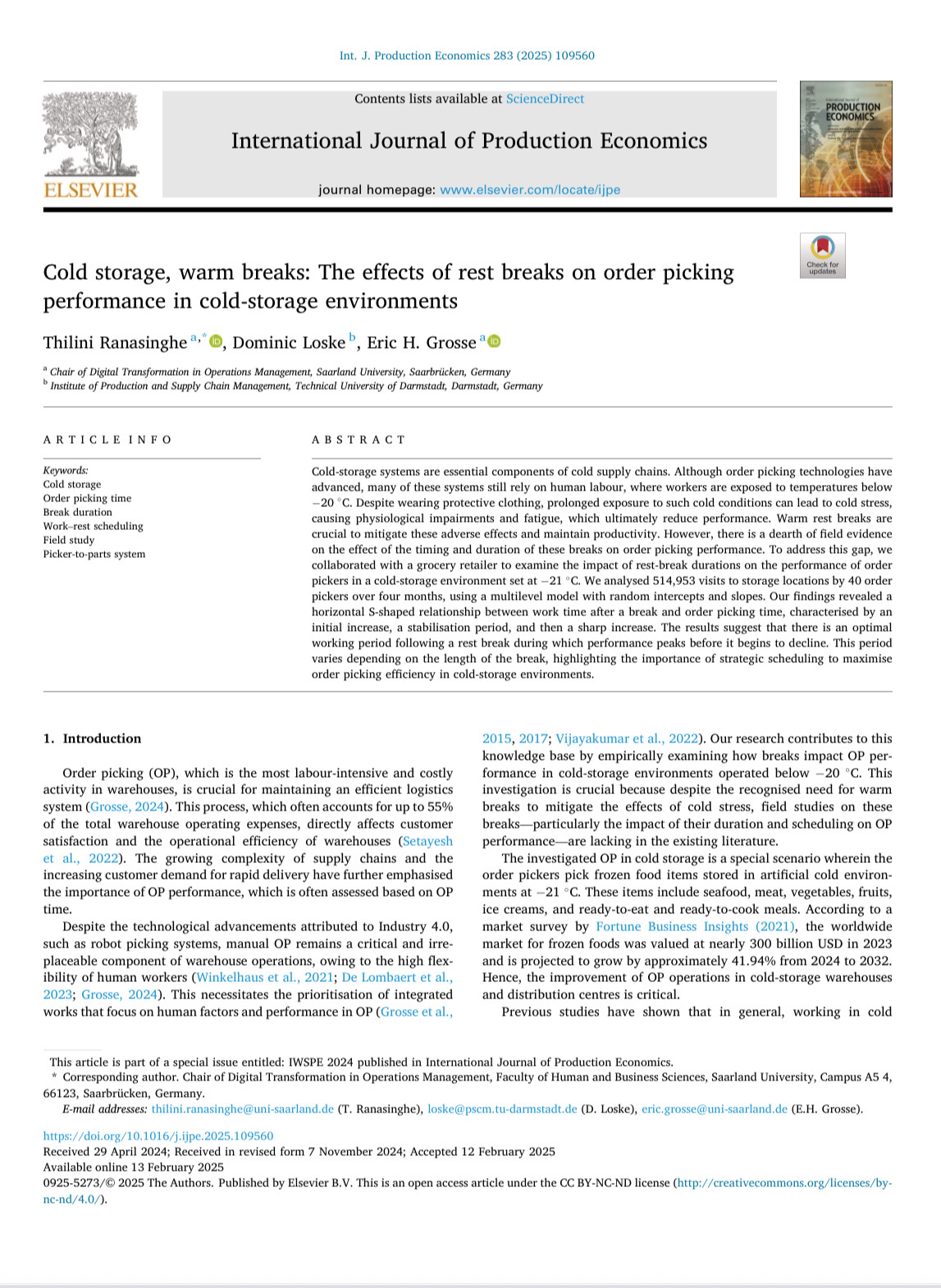
Cold storage, warm breaks: The effects of rest breaks on order picking performance in cold-storage environments
Ranasinghe, Loske & Grosse (2025)
Cold-storage systems are essential components of cold supply chains. Although order picking technologies have advanced, many of these systems still rely on human labour, where workers are exposed to temperatures below − 20 ◦C. Despite wearing protective clothing, prolonged exposure to such cold conditions can lead to cold stress, causing physiological impairments and fatigue, which ultimately reduce performance. Warm rest breaks are crucial to mitigate these adverse effects and maintain productivity. However, there is a dearth of field evidence on the effect of the timing and duration of these breaks on order picking performance. To address this gap, we collaborated with a grocery retailer to examine the impact of rest-break durations on the performance of order pickers in a cold-storage environment set at − 21 ◦C. We analysed 514,953 visits to storage locations by 40 order pickers over four months, using a multilevel model with random intercepts and slopes. Our findings revealed a horizontal S-shaped relationship between work time after a break and order picking time, characterised by an initial increase, a stabilisation period, and then a sharp increase. The results suggest that there is an optimal working period following a rest break during which performance peaks before it begins to decline. This period varies depending on the length of the break, highlighting the importance of strategic scheduling to maximise order picking efficiency in cold-storage environments.
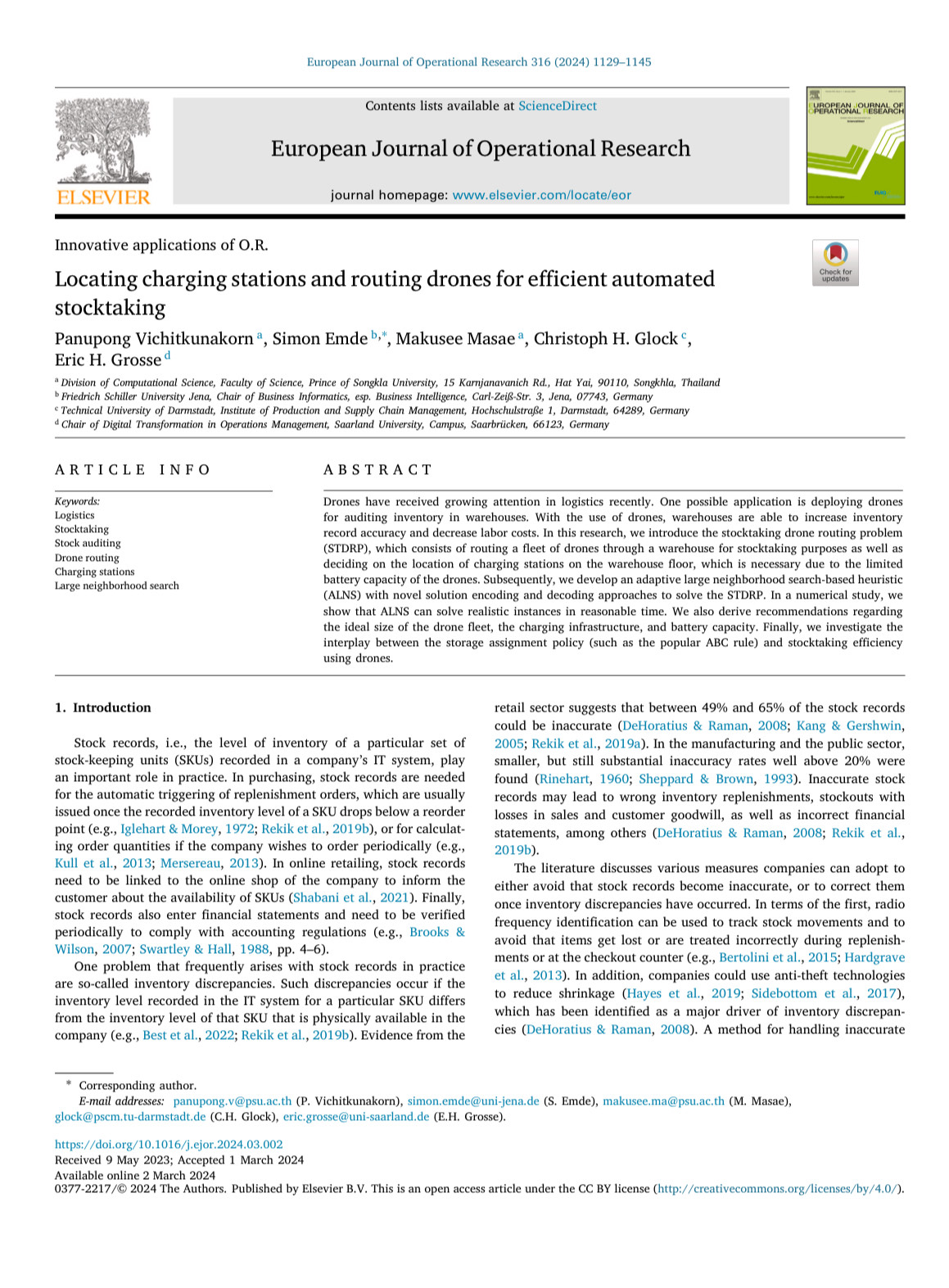
Locating charging stations and routing drones for efficient automated stocktaking
Vichitkunakorn, Emde, Masaea, Glock & Grosse (2024)
Drones have received growing attention in logistics recently. One possible application is deploying drones for auditing inventory in warehouses. With the use of drones, warehouses are able to increase inventory record accuracy and decrease labor costs. In this research, we introduce the stocktaking drone routing problem (STDRP), which consists of routing a fleet of drones through a warehouse for stocktaking purposes as well as deciding on the location of charging stations on the warehouse floor, which is necessary due to the limited battery capacity of the drones. Subsequently, we develop an adaptive large neighborhood search-based heuristic (ALNS) with novel solution encoding and decoding approaches to solve the STDRP. In a numerical study, we show that ALNS can solve realistic instances in reasonable time. We also derive recommendations regarding the ideal size of the drone fleet, the charging infrastructure, and battery capacity. Finally, we investigate the interplay between the storage assignment policy (such as the popular ABC rule) and stocktaking efficiency using drones.
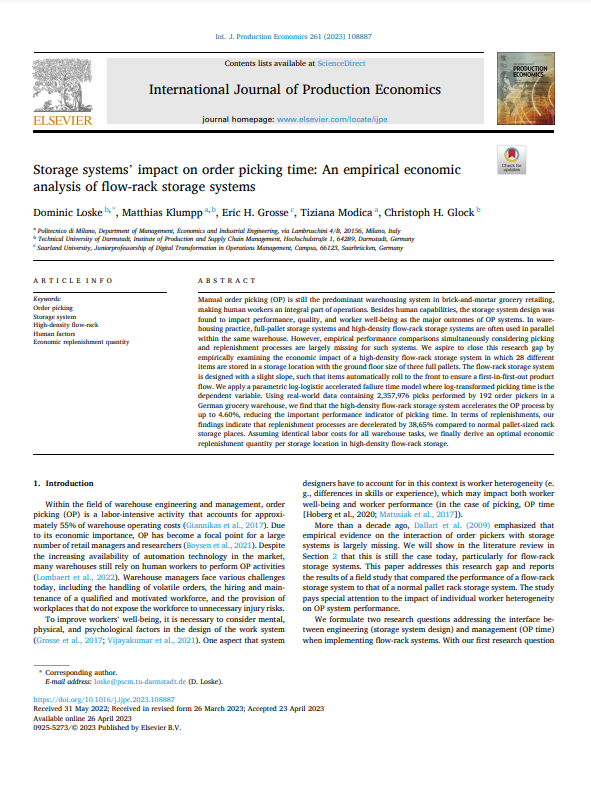
Storage systems’ impact on order picking time: An empirical economic analysis of flow-rack storage systems
Loske, Klumpp, Grosse, Modica & Glock (2023)
Manual order picking (OP) is still the predominant warehousing system in brick-and-mortar grocery retailing, making human workers an integral part of operations. Besides human capabilities, the storage system design was found to impact performance, quality, and worker well-being as the major outcomes of OP systems. In warehousing practice, full-pallet storage systems and high-density flow-rack storage systems are often used in parallel within the same warehouse. However, empirical performance comparisons simultaneously considering picking and replenishment processes are largely missing for such systems. We aspire to close this research gap by empirically examining the economic impact of a high-density flow-rack storage system in which 28 different items are stored in a storage location with the ground floor size of three full pallets. The flow-rack storage system is designed with a slight slope, such that items automatically roll to the front to ensure a first-in-first-out product flow. We apply a parametric log-logistic accelerated failure time model where log-transformed picking time is the dependent variable. Using real-world data containing 2,357,976 picks performed by 192 order pickers in a German grocery warehouse, we find that the high-density flow-rack storage system accelerates the OP process by up to 4.60%, reducing the important performance indicator of picking time. In terms of replenishments, our findings indicate that replenishment processes are decelerated by 38,65% compared to normal pallet-sized rack storage places. Assuming identical labor costs for all warehouse tasks, we finally derive an optimal economic replenishment quantity per storage location in high-density flow-rack storage.
On the causes of positive inventory discrepancies in retail stores
Best, Glock, Grosse, Rekik & Syntetos (2022)
International Journal of Physical Distribution & Logistics Management
Purpose: Ensuring high on-shelf availability at low inventory costs remains an important challenge in retailing. Inaccurate inventory records, i.e. discrepancies between the stock records displayed in the inventory system and the stock quantity actually found in the retail store, have been identified as one of the most important drivers of retail stockouts in the past. The purpose of this work is to investigate the causes of positive inventory discrepancies in retailing, i.e. where there is more inventory on-hand than identified by the inventory system. Design/methodology/approach: Based on input from retailers, the authors develop a simulation model of a retail store that considers various error-prone processes and study in a full factorial test design how the different operational errors may drive inventory discrepancies, paying special attention to the sources of positive inventory record inaccuracies. Findings: This makes it possible to gain insights into the process parameters retailers need to adjust to avoid inventory records becoming inaccurate. In addition, the authors analyze how positive inventory discrepancies relate to stockouts to further our understanding of the role so-called phantom products may play in a retailing context. Originality/value: While negative inventory discrepancies (where the stock that is available in the store is less than what the system displays) and their sources (theft, shrinkage, etc.) have been discussed quite frequently in the literature, the causes of positive inventory discrepancies (where the available inventory exceeds the system inventory) have received much less attention.
New solution procedures for the order picker routing problem in U‑shaped pick areas with a movable depot
Diefenbach, Emde, Glock & Grosse (2021)
OR Spectrum
This paper develops new solution procedures for the order picker routing problem in U-shaped order picking zones with a movable depot, which has so far only been solved using simple heuristics. The paper presents the first exact solution approach, based on combinatorial Benders decomposition, as well as a heuristic approach based on dynamic programming that extends the idea of the venerable sweep algorithm. In a computational study, we demonstrate that the exact approach can solve small instances well, while the heuristic dynamic programming approach is fast and exhibits an average optimality gap close to zero in all test instances. Moreover, we investigate the influence of various storage assignment policies from the literature and compare them to a newly derived policy that is shown to be advantageous under certain circumstances. Secondly, we investigate the effects of having a movable depot compared to a fixed one and the influence of the effort to move the depot.
The impact of controllable production rates on the performance of inventory systems: A systematic review of the literature
Glock & Grosse (2020)
European Journal of Operational Research 288(3)
The lot sizing problem has attracted the attention of researchers for more than a century, and it still belongs to the most relevant decision problems in many manufacturing companies. During the evolution of research on lot sizing, the seminal economic order quantity (EOQ) model proposed by Harris [1913. How many parts to make at once. Factory, the Magazine of Management, 10 (2), 135-136.] has remained the most popular model, despite its limitations. To support lot sizing decisions in practice, researchers have frequently extended Harris’ basic EOQ model to better reflect the characteristics of real production processes. One of these extensions is the consideration of controllable (variable) production rates, which gives production planners more flexibility in managing the build-up and depletion of inventory and in controlling costs. The aim of this paper is to provide a comprehensive and systematic overview of EPQ-type lot sizing models that consider controllable production rates. First, the paper proposes a conceptual framework that captures the characteristics of controllable production rates including the planning horizon (short vs. long term), the number of potential interventions per production run (one vs. multiple), the effect of controllable production rates on the performance of the inventory system (e.g., unit production costs, energy consumption, product quality), and the type of lot sizing model considered (e.g., two-stage models, multi-stage models, multi-item models). Secondly, the paper presents the results of a systematic literature review and evaluates the state-of-research of lot sizing models with controllable production rates. Based on the analysis of the literature, key trends are summarized and promising research opportunities are discussed.
Order picker routing in warehouses: A systematic literature review
Masae, Glock & Grosse (2019)
International Journal of Production Economics 224
Order picking has often been described as one of the most labor- and time-consuming internal logistics processes. In manual picker-to-parts order picking systems, order pickers often spend a significant amount of time on travelling through the warehouse to reach storage positions where required items are stored. To reduce the cost of order picking, researchers have developed various optimal and heuristic routing policies in the past. This paper presents the results of a systematic review of research on order picker routing. First, it identifies order picker routing policies in a systematic search of the literature and then develops a conceptual framework for categorizing the various policies. Order picker routing policies identified during the literature search are then descriptively analyzed and discussed in light of the developed framework. The paper also derives insights into the frequencies of usage of the different routing policies available in the literature and applies a citation analysis to identify seminal works that shaped the literature on order picker routing. The paper concludes with an outlook on future research opportunities.
Green warehousing: Systematic literature review and bibliometric analysis
Bartolini, Bottani & Grosse (2019)
Journal of Cleaner Production 226
Warehouses are major contributors to the rise of greenhouse gas emissions in supply chains. Thus, it is not surprising that the attention of academic research to green and sustainable warehousing has been growing in recent years. This attention has led to an increasing number of publications in this field, which is why a systematic literature review on the topic of green warehousing is proposed in the paper at hand. This work provides a comprehensive overview and classification of the existing research on green warehousing, summarizes and synthesizes the available knowledge on this topic, and identifies key trends. Based on the evaluation of the literature, promising ideas for future research are proposed. Citation and network analyses are carried out to evaluate the relationships among the topics covered. The results show an increasing interest in sustainability topics within the warehousing literature, where energy saving has been the most frequently studied objective, followed by environmental impact of warehouse buildings, and green warehouse management in general. The green warehousing literature, however, lacks case studies and empirical data. The main contribution of this paper is an exhaustive summary of the state of knowledge on green warehousing in terms of the macro-themes addressed, the specific topics investigated and the methodological approaches, including a comprehensive and systematic classification of the relevant literature. An outline of managerial guidelines about green warehouse management and the propositions of future research ideas contribute to the further development of this emerging research field.
Picker routing and storage-assignment strategies for precedence-constrained order picking
Žulj, Glock, Grosse & Schneider (2018)
Computers & Industrial Engineering 123
Order picking describes the process of retrieving items from their storage locations to satisfy customer orders. Because order picking is considered the most labor-intensive process in warehousing, effectively routing order pickers through a warehouse can result in considerable time and cost savings. In practice, picker routing is often influenced by precedence constraints, i.e., the order-picking sequence is partially predetermined due to fragility restrictions, stackability, shape, size, and preferred unloading sequence. Although many warehouses face such precedence constraints for picking items (especially in the grocery sector), they are hardly considered in the scientific literature. This paper is inspired by a practical case observed in a warehouse of a German manufacturer of household products, where heavy items are not allowed to be stored on top of light items to prevent damage to the light items. Currently, the sequence for retrieving the items from their storage locations is determined by applying a picker-routing strategy that neglects this precedence constraint, and the order pickers pack the items respecting their weights after picking. To avoid this sorting effort at the end of the order-picking process, we propose a picker-routing strategy that incorporates the precedence constraint by picking heavy items before light items. We develop an exact solution method to evaluate this strategy. Furthermore, we examine the influence of different problem parameters on the proposed picker-routing strategy, and we derive managerial insights for dealing with precedence constraints in order picking.
Decision support models for supplier development: Systematic literature review and research agenda
Glock, Grosse & Ries (2017)
International Journal of Production Economics 193
The continuing trend towards sourcing components and semi-finished goods for less vertically integrated manufacturing systems globally leads to a dramatic increase in supply options for companies. To ensure that companies benefit from the potentials global sourcing offers, supplier-buyer relationships need to be managed efficiently. Due to the decreasing share of value-adding activities provided in-house, suppliers are more and more considered as an essential contributor to the buying company’s competitive position. Consequently, to realize and sustain competitive advantages, companies try to establish institutionalized long-term relationships to their most important suppliers and to actively improve the productivity and performance of their supplier base. To support supplier development in practice, researchers have developed decision support models that provide assistance in selecting and implementing suitable supplier development activities. The aim of this paper is to provide a comprehensive and systematic overview of decision support models for supplier development and to develop a research agenda that helps to identify promising areas for future research in this area. First, typical applications for supplier development as well as potential development measures that can be adopted to improve the performance of suppliers are identified. Secondly, a systematic literature review with a focus on decision support models for supplier development is conducted. Based on the analysis of the literature, we define a research agenda that synthesizes key trends and promising research opportunities and thus highlight areas where more decision support models are needed to foster supplier development initiatives in practice.
Machine scheduling problems in production: A tertiary study
Abedinnia, Glock, Grosse & Schneider (2017)
Computers & Industrial Engineering 111
This paper presents the results of a comprehensive and systematic review of 129 literature reviews on machine scheduling problems in production (MSPP). The paper first proposes a conceptual framework that considers the main attributes of MSPP in 7 categories and 75 sub-categories. After a descriptive analysis of the sampled papers that give insights into publication patterns for MSPP, a quantitative analysis of the sampled review papers is carried out based on the proposed framework. A synthesis of research findings describes the state of knowledge and unveils general deficiencies of literature reviews on MSPP. In addition, the paper provides a comprehensive overview of MSPP, which supports researchers in positioning their own work in the literature and in finding potential innovative research areas. The paper concludes with an outlook on future research opportunities in the area of MSPP.
Environmental impact of warehousing: a scenario analysis for the United States
Ries, Grosse & Fichtinger (2016)
International Journal of Production Research 55(21)
In recent years, there has been observed a continued growth of global carbon dioxide emissions, which are considered as a crucial factor for the greenhouse effect and associated with substantial environmental damages. Amongst others, logistic activities in global supply chains have become a major cause of industrial emissions and the progressing environmental pollution. Although a significant amount of logistic-related carbon dioxide emissions is caused by storage and material handling processes in warehouses, prior research mostly focused on the transport elements. The environmental impact of warehousing has received only little attention by research so far. Operating large and highly technological warehouses, however, causes a significant amount of energy consumption due to lighting, heating, cooling and air condition as well as fixed and mobile material handling equipment which induces considerable carbon dioxide emissions. The aim of this paper is to summarise preliminary studies of warehouse-related emissions and to discuss an integrated classification scheme enabling researchers and practitioners to systematically assess the carbon footprint of warehouse operations. Based on the systematic assessment approach containing emissions determinants and aggregates, overall warehouse emissions as well as several strategies for reducing the carbon footprint will be studied at the country level using empirical data of the United States. In addition, a factorial analysis of the warehouse-related carbon dioxide emissions in the United States enables the estimation of future developments and facilitates valuable insights for identifying effective mitigation strategies.
Assessing the environmental impact of integrated inventory and warehouse management
Fichtinger, Ries, Grosse & Baker (2015)
International Journal of Production Economics 170
There has been considerable research on the environmental impact of supply chains but most of this has concentrated on the transport elements. The environmental impact of warehousing has received relatively little attention except within the context of distribution networks. A high proportion of total warehouse emissions emanate from heating, cooling, air conditioning and lighting and these aspects are largely related to warehouse size. This in turn is greatly influenced by inventory management, affecting stockholding levels, and warehouse design, affecting the footprint required for holding a given amount of stock. Other emissions, such as those caused by material handling equipment, are closely related to warehouse throughput and equipment choice. There is a substantial gap in the literature regarding this interaction between inventory and warehouse management and its environmental impact. The purpose of this paper is to contribute to filling this gap. Therefore, an integrated simulation model has been built to examine this interaction and the results highlight the key effects of inventory management on warehouse-related greenhouse gas emissions. In particular, it is found that decisions on supply lead times, reorder quantities, and storage equipment all have an impact on costs and emissions and therefore this integrated approach will inform practical decision making. Additionally, it is intended that the paper provides a framework for further research in this important area.
The lot sizing problem: A tertiary study
Glock, Grosse & Ries (2014)
International Journal of Production Economics 155(1-3)
This paper provides a survey of literature reviews in the area of lot sizing. Its intention is to show which streams of research emerged from Harris' seminal lot size model, and which major achievements have been accomplished in the respective areas. We first develop the methodology of this review and then descriptively analyze the sample. Subsequently, a content-related classification scheme for lot sizing models is developed, and the reviews contained in our sample are discussed in light of this classification scheme. Our analysis shows that various extensions of Harris' lot size model were developed over the years, such as lot sizing models that include multi-stage inventory systems, incentives, or productivity issues. The aims of our tertiary study are the following: firstly, it helps primary researchers to position their own work in the literature, to reproduce the development of different types of lot sizing problems, and to find starting points if they intend to work in a new research direction. Secondly, the study identifies several topics that offer opportunities for future secondary research.
A simulated annealing approach for the joint order batching and order picker routing problem with weight restrictions
Grosse, Glock & Ballester-Ripoll (2014)
International Journal of Operations and Quantitative Management 20(2)
This paper studies the joint order batching and order picker routing problem in conventional multi-parallel-aisle picker-to-part order picking systems. It complements prior publications by considering a capacity constraint that is formulated as a function of total item weight, instead of item count. A mathematical model is formulated and a simulated annealing algorithm is developed to batch orders and to determine pick tours. The intention of the paper is to provide a more realistic model and to improve classical batching and routing heuristics. It thereby pays special attention to the practical applicability of the model. The proposed methods are compared and evaluated in an extensive numerical study, and it is shown that the developed approach leads to an improved solution for the joint order batching and order picker routing problem, as compared to classical heuristics for this problem.
Storage policies and order picking strategies in U-shaped order-picking sytems with a movable base
Glock & Grosse (2012)
International Journal of Production Research 50(16)
Prior research on storage policies and order-picking strategies in order-picking systems has concentrated on studying warehouses with parallel shelves that are separated by horizontal and/or vertical aisles. This paper analyses a special case of an order-picking system where the warehouse is divided into zones with shelves being arranged in the shape of a U in each of the zones. The paper assumes that the shelves of the order-picking system are made up of two rows of stillages that can be flexibly exchanged and that the base of the order-picking process can be moved within the aisle prior to the beginning of the order-picking process. We describe the order-picking system in a formal model and propose different storage location assignment policies whose efficiency is compared in a numerical study. The paper pays special attention to the practical applicability of the model and proposes heuristics that can be easily implemented in practice.


